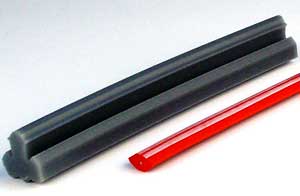Silicone Extrusion
 With the Silicone Extrusion process, raw material (normally in strips) is fed continuously into the extruder. The raw material is heated through the action of the screw and heaters until it is warm and extremely fluid. The (now) fluid silicone is propelled through the extruder by a variable speed auger screw. The silicone is continuously forced through a die that forms it to the desired cross-sectional size and shape. Once extruded, the silicone passes through an LCM ‘curing tunnel’, usually consisting of three inorganic salts to facilitate the chemical reaction of vulcanization.
With the Silicone Extrusion process, raw material (normally in strips) is fed continuously into the extruder. The raw material is heated through the action of the screw and heaters until it is warm and extremely fluid. The (now) fluid silicone is propelled through the extruder by a variable speed auger screw. The silicone is continuously forced through a die that forms it to the desired cross-sectional size and shape. Once extruded, the silicone passes through an LCM ‘curing tunnel’, usually consisting of three inorganic salts to facilitate the chemical reaction of vulcanization.

The benefits derived when the application suits the silicone class of materials, include a wide variety of commercially available silicone compounds, low compression set, excellent thermal insulating properties, resistance to fire, approval for use in food contact applications, good elasticity, resistance to temperatures up to 500°F, resistance to ozone and availability in a wide range of hardnesses.
Silicone is extruded to make tubing, rods, gaskets and seals. Compression molded silicone is used in the production of spark plug covers and various medical applications.
Medical applications for extruded silicone include catheters, drain and fluid-path tubes gaskets, ribbon, sheathing, balloon cuffs and co-extruded electrical conductors.



